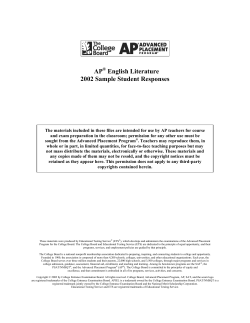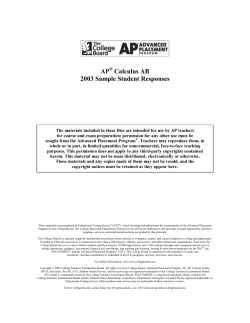
Business Find out how to prove — and improve — ETS
Find out how to prove — and improve — the effectiveness of your Business program with the ETS® Major Field Tests. Content Validity The ETS® Major Field Test (MFT) in Business, first administered in 1990, assesses mastery of concepts, principles and knowledge by graduating Business students. To ensure fairness and content relevance, the test is revised approximately every four to five years. Developed by Leading Educators in the Field Experienced faculty members representing all of the relevant areas of the discipline determine test specifications, questions and types of scores reported. ETS assessment experts subject each question to rigorous tests of sensitivity and reliability. Every effort is made to include questions that assess the most common and important topics and skills. In addition to factual knowledge, the test evaluates students’ abilities to analyze and solve problems, understand relationships and interpret material. Questions that require interpretation of graphs, diagrams and charts are included. Academic departments may add up to two subgroups and as many as 50 additional locally written questions to test areas of the discipline that may be unique to the department or institution. National Comparative Data A Comparative Data Guide, published each year, contains tables of scaled scores and percentiles for individual student scores, departmental mean scores and any subscores or group assessment indicators that the test may support. The tables of data are drawn from senior-level test takers at a large number of diverse institutions. Nearly 1,500 colleges and universities employ one or more of the Major Field Tests for student achievement and curriculum evaluation each year. Who Develops the MFT in Business? Individuals who serve or recently have served on the Committee for the MFT in Business are faculty members from the following institutions: California State University, Fullerton Delta State University Florida Southern College Marymount University Middle Tennessee State University Murray State University Rider University Saint Vincent College University of Central Oklahoma University of Phoenix University of Texas at El Paso For more information about the MFT in Business: Phone: 1-800-745-0269 Email: highered@ets.org Visit: www.ets.org/mft Educational Testing Service Rosedale Road Princeton, NJ 08541 Test Content — Business (4JMF) The Major Field Test in Business contains 120 multiple-choice items; some are based on case studies. The questions are designed to measure a student’s knowledge and ability to apply that knowledge analytically. To assess levels of achievement, Business Test questions cover a broad range of difficulty, and encompass both the depth and the breadth of business knowledge. The programs can select the time and venue of the two-hour test, which may be split into two sessions. This test must be given by a proctor. Mathematical operations do not require the use of a calculator. Following the general guidelines of business school accrediting agencies, the Business Test covers areas outlined in the Common Core Standards for undergraduate business education. Two assumptions inform the Business Test: 1) most institutions will offer a common core that includes accounting, economics, finance, law, management, marketing, information systems, quantitative analysis and international business; 2) the Common Core will address important social and international considerations of modern business operations. The Business Test has five key objectives: 1. Measure students’ knowledge of the multidisciplinary subject matter representative of undergraduate business education 2. Provide information to students regarding their level of achievement 3. Provide information on student achievement to faculty to enable institutions to assess their performance relative to their specific mission and objectives 4. Provide information to facilitate development of appropriate goals and educational programs 5. Strengthen the accountability of undergraduate business education The distribution of the content areas with some examples of the topics covered is as follows: I. Accounting (~15%) A. Financial accounting 1. Conceptual foundations 2. Income statement and statement of retained earnings 3. Balance sheet 4.Statement of cash flows B.Managerial accounting 1. Cost concepts 2. Product-costing systems 3. Activity-based costing 4.Cost, volume and profit analysis 5. Budgeting (except capital budgeting covered under Finance) 6. Standard costing 7. Nonroutine decision making C. International accounting II. Economics (~13 %) A.Basic Economic Concepts 1.Scarcity and opportunity cost 2. Production possibilities frontier 3. Comparative advantage and specialization 4. Economic systems B.Microeconomics 1. Supply and demand 2.Models of consumer choice 3. Production and costs 4. Product market structures 5. Resource markets 6.Market failure and the role of government C.Macroeconomics 1.Measurement of economic performance 2. Aggregate demand and aggregate supply 3.Money and the banking system 4.Monetary policy and fiscal policy 5. Economic growth D. International economics 1.International trade and policy 2. Exchange rates 3. Balance of payments I II. Management (~15%) A. Management principles 1. History and theory 2. Functions (organizing, leading, planning and controlling) 3. Group/team dynamics B. Organizational behavior 1. Leadership and motivation 2.Communication 3. Managing diversity 4. Human resource management C. Operations Management 1. Operations design 2. Operations execution 3. Total quality management D.Strategy and policy 1. Strategic analysis 2. Policy determination E. International/cross cultural management F. Entrepreneurship 4. Network and internet technology C.Business Information Systems 1. Automation and support systems 2. Transaction processing systems 3. Management information systems 4.Decision support and expert systems 5. Enterprise systems (ERP) D. Systems Development 1. Systems investigation and analysis 2. Systems planning development and implementation IV.Quantitative Business Analysis (~11%) A.Probability and statistics 1.Measure of set operations 2. Conditional/joint probabilities 3. Counting rules 4.Measures of central tendency and dispersion 5. Distributions (including normal and binomial) 6. Sampling and estimation 7. Hypothesis testing 8. Correlation and regression 9. Time-series forecasting 10.Statistical concepts in quality control B. Quantitative Operations Management Techniques 1. Linear programming 2. Project scheduling (including PERT and CPM) 3. Inventory modeling 4. Statistical process control 5. Special topics (including queuing theory, simulation and decision analysis) I. Finance (~13%) V A. Corporate Finance 1.Time value of money 2. Capital budgeting 3. Working capital management 4. Financial statement analysis 5. Cost of capital 6. Capital structure B. Investments 1. Risk and returns 2. Valuation of securities 3. Financial markets and environments C. International Finance II. Marketing (~13%) V A.Identifying attractive markets 1. Strategic marketing planning 2. Scanning marketing environment 3. Marketing research and information technology tools 4. Consumer and organizational buyer behavior B.Serving Selected Markets 1.The marketing mix (Product, Price, Place and Promotion) 2. Segmenting consumer and organizational markets 3. Marketing services 4. Marketing for not-for-profit organizations 5.Marketing of social causes C. International Marketing V. Information Systems (~10%) A.Information Systems in Business and Society 1.Information management in a global society 2.Security, privacy and ethical issues B. Information Technology Concepts 1.Hardware technology III. Legal and Social V 2. Software technology Environment (~10%) 3. Database management systems A. Legal environment 1.Courts and legal systems 2. Constitution and business 3. Administrative law 4. Tort law 5. Crimes B. Regulatory environment 1. Employment law 2. Labor law 3. Antitrust law 4. Consumer protection 5. Environmental and international law 6. Security regulation C. Business relationships 1.Contract and sales law (UCC) 2. Business organizations 3. Law of agency 4. Intellectual property D.Ethics and Social Responsibility 1. Ethics 2. Social responsibility IX.International Issues (overlapping and drawn from other content areas above) How scores for the Major Field Test in Business are reported: Total Score — Reported for each student and summarized for the group Assessment Indicators — Reported for the group* only – Accounting (18) – Economics (16) – Management (18) – Quantitative Business Analysis (13) – Information Systems (12) – Finance (16) – Marketing (16) – Legal and Social Environment (12 – International Issues (~12, drawn from other content areas) Numbers in parentheses are the approximate number of questions in each category. *A minimum of five (5) students is required for assessment indicators to be reported. Copyright © 2013 by Educational Testing Service. All rights reserved. ETS, the ETS logo and LISTENING. LEARNING. LEADING. are registered trademarks of Educational Testing Service (ETS). 23442
© Copyright 2025





















